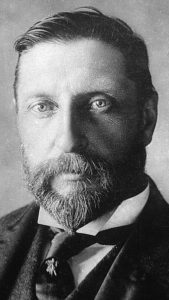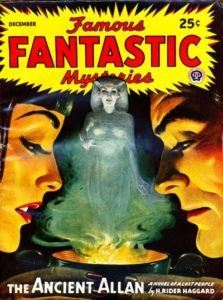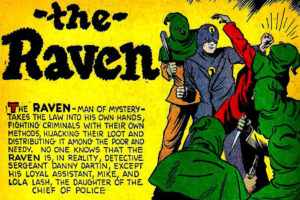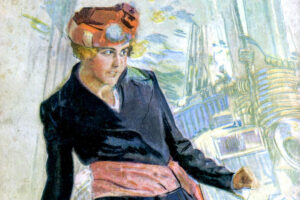
A popular element of many pulp fiction adventure, science fiction, and fantasy stories is the “lost world,” a land removed and unknown to the rest of the world were there are ancient people and animals. Maybe cave men and dinosaurs, or a still existing group of Atlantians, Romans, or similar ancient or legendary people. They can be a high tech civilization, or a former high tech civilization that has fallen. This lost world could be in an inaccessible valley, or on a mountain, or island, or even inside the Earth or under the sea.
The person credited with creating this genre is H. Rider Haggard (1856-1925). His best known works are King Solomon’s Mines (1885) and She (1886), both of which have had several adaptations over the years. Surprisingly, few of his works were reprinted in the pulps, but there are numerous pulp stories clearly inspired by him. In addition to lost worlds, he also gave us the larger than life adventurer Allan Quatermain and She, the mysterious immortal.
Allan Quatermain is the quintessential “great white hunter” and had over a dozen novels and stories of him, taking him from his early years to his death. King Solomon’s Mines, which introduces him, was actually set late in his life. He had two wives and outlived a son. Most modern people, if they recall him, is probably from the League of Extraordinary Gentleman movie.
In Mines, Quatermain is asked to help find the lost brother of one of a group of adventurers. This takes then into an unexplored area of Africa. Here they find an unknown group of Zulus, and learn that Quatermain’s African companion is their rightful king. After a fight between rival factions, they find the mines and escape a deathtrap. Leaving to go back to civilization, they find the lost brother and return to England.
There are many more novels of Alan Quatermain that cover his life from age 15 to his death at 68. Notable works are the “Zulu trilogy” of Marie (1912), Child of Storm (1913), and Finished (1917), She and Allan (1920), which crosses over Quatermain with She, and Allan Quatermain (1887), which details his death after a final adventure with his companions from Mines.
Ayesha, better known as She — short for “She Who Must Be Obeyed” — is Haggard’s other major character. She is a near-immortal white queen who rules over a lost land in Africa called Kor. Kor was an advanced civilization that predates the Egyptians, though Ayesha is apparently Egyptian, who found the ruined kingdom 2,000 years ago and bathed in the Pillar of Fire, making her immortal. She is waiting for her lost love, the Greek Kallikrates, and believes one of the adventures who has found Kor is him reincarnated. But when she tries to demonstrate the Pillar, after entering it for a second time, she reverts to her natural age and dies, promising to return.

This would lead to three sequels: Ayesha: The Return of She (1905), She and Allan (1921), Wisdom’s Daughter (1923). In Ayesha, her reincarnated lover thinks she has not died, and looks for her, eventually traveling to Tibet. There they find two lost races, one a group of descendants of Alexander the Great‘s army. The other is ruled over by She reincarnated. But there is no happy ending here. She and Allan tells of the meeting of the two characters, and this is set before She. Wisdom’s Daughter can be thought of She’s memoirs, telling of her early life and her meeting Kallikrates and his death.
Haggard wrote other works. Some are other lost world stories (The People of the Mist, The Heart of The World, The Yellow Gods), but not always. Not all of his other lost world stories are set in Africa. Some are set in the Americas or islands in the Pacific. There is Eric Brighteyes, about an ancient Viking. Others are set in the past or even distant past. He co-wrote three novels with Andrew Lang: The World’s Desire, Montezuma’s Daughter, and Stella Fregelius.
Several of this works have been adapted into movies, TV shows, comics, and more. I am aware of a few new works using Allan Quatermain, including a series of new stories from Airship 27.
Haggard continues to be popular enough that many of his works are still available, and several were reprinted in various fantasy reprint series. Several were included in the Forgotten Fantasy Library and a couple in the Ballantine Adult Fantasy Series in the early 1970s, and Del Rey reprinted the Ayesha series and a few others later in a uniform style in the late ’70s. Leonaur has reprinted the entire Allan Quatermain series in about 10 volumes, and put out other volumes reprinted the rest of Haggards works.
If lost world novels interest you, read the works that inspired them. Check them out. I hope to have more detailed review of specific works in the future.
POSTING #500!




I think those interested should nip over to Roy Glashan’s Library (or go via Project Gutenberg Australia) for nice ebooks of Haggard. Roy Glashan’s versions have original illustrations where available and are always well done in every respect.
Thank you for putting a spotlight on H.Rider Haggard, Grandfather of the Adventure Novel. His work, both alone and with co-authors such as Andrew Lang and Rudyard Kipling, has had an immense influence on many writers in the generations since.
I’d like to second your recommendation to visit Roy Glashan’s Library; it is a wonderful resource for anyone interested in the classics that have inspired the fields of Fantasy and Science Fiction.